Honor Award
The Horizontal Dike
Yongjun Jo, Student ASLA & Kyungkun Lee, Student ASLA, Graduate, University of Pennsylvania
Advisor: Karen M’Closkey, ASLA
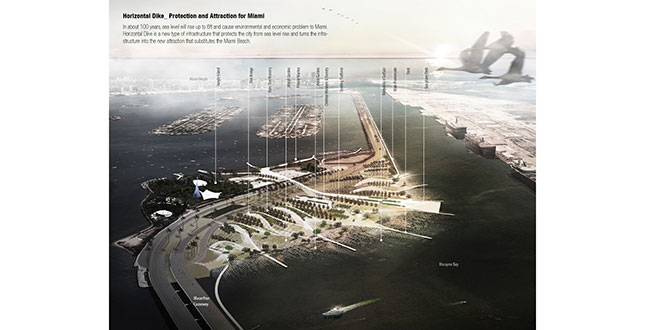 Close Me!
Close Me!Horizontal Dike - Protection and Attraction for Miami
In about 100 years, sea level will rise up to 6ft and cause environmental and economic problem to Miami. Horizontal Dike is a new type of infrastructure that protects the city from sea level rise and turns the infra-structure into the new attraction that substitutes the Miami Beach.
Download Hi-Res ImageImage: Yongjun Jo, Kyungkun Lee
Image 1 of 15
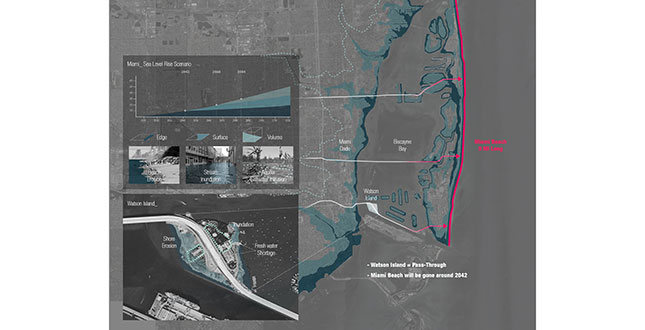 Close Me!
Close Me!Sea Level Rise - Imminent threat on Attractions and Ecosystem of Miami
The impact of Sea Level Rise starts from the shore and further expands to the urban area and aquifer. Watson Island has all the characteristics that represent the damages and therefore has a potential to be the test bed site to invent and test the infrastructure for the future use of the entire Biscayne Bay area.
Download Hi-Res ImageImage: Yongjun Jo, Kyungkun Lee
Image 2 of 15
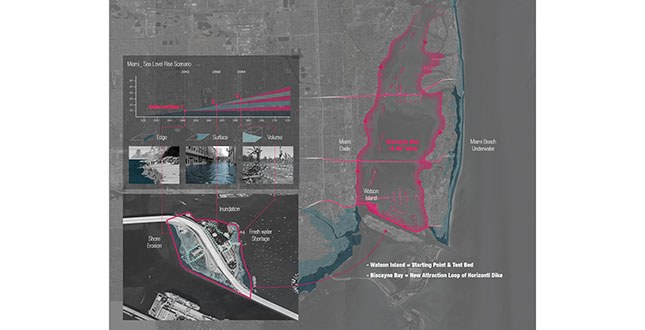 Close Me!
Close Me!Watson Island - Test Bed for the Horizontal Dike
Horizontal Dike on the Watson Island will be applied to the entire Biscayne Bay Area based on the scenario, and will eventually forms the new attraction loop to substitute the Miami Beach which will disappear in 50 years. Also, the Watson Island will be the starting point of the tour, depart form mere pass-through.
Download Hi-Res ImageImage: Yongjun Jo, Kyungkun Lee
Image 3 of 15
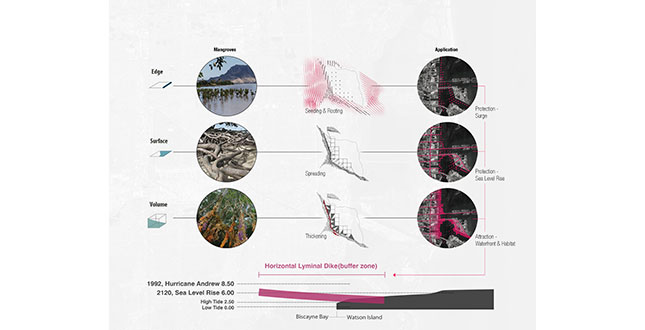 Close Me!
Close Me!Horizontal Dike - New Infrastructural Waterfront of Protection and Attraction
The Horizontal Dike will evolve from points to surface and ultimately to volume as the root system of the mangroves inhabits and expands its territory while protecting the area from surge and inundation.
Download Hi-Res ImageImage: Yongjun Jo, Kyungkun Lee
Image 4 of 15
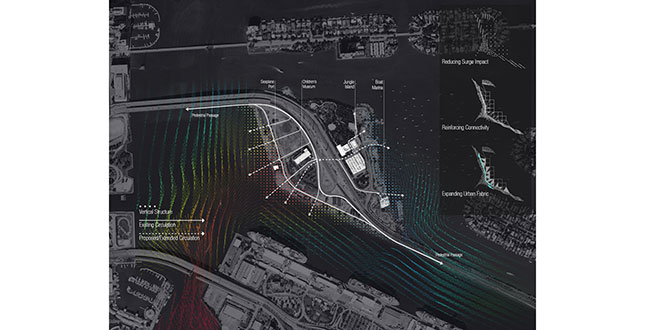 Close Me!
Close Me!Responding to the Context and Threats
Vertical structures of the Horizontal Dikes will be placed according to the wave of the shore, so they will reduce the erosion and surge impact. They will also respond to the existing circulations and further expand them to afford better circulation and connectivity both for the sight and from Miami Dade.
Download Hi-Res ImageImage: Yongjun Jo, Kyungkun Lee
Image 5 of 15
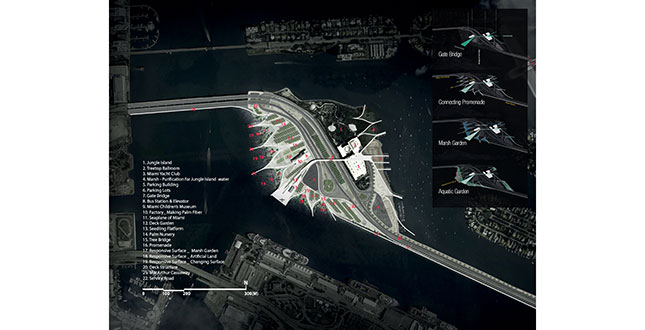 Close Me!
Close Me!Offering a New type of Waterfront
The Horizontal Dike is not just infrastructure, but also extended urban fabric which offers various extended waterfront edge and surface conditions. The frame work of the dike will also be utilized as circulations to connect the Children’s Museum and the Jungle Island so they could be part of the new urban waterfront.
Download Hi-Res ImageImage: Yongjun Jo, Kyungkun Lee
Image 6 of 15
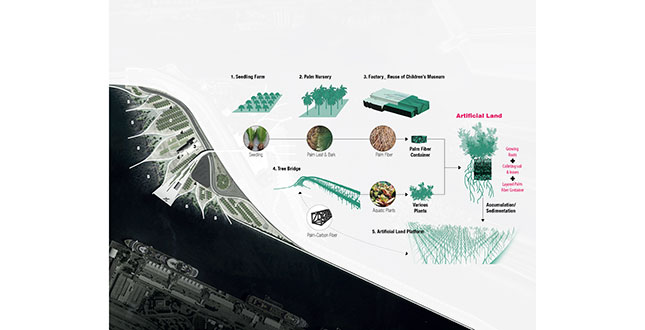 Close Me!
Close Me!Artificial Land driven by Natural Process
The Horizontal Dike System is a hybrid of cutting edge technology and law of nature. It starts with the artificial land platform of special palm-carbon fiber, but will be eventually filled with decomposed organic materials such as palm fiber, soil, falling leaves and fruits which will form the fertile ground of the future habitat. All the process - both artificial and natural - of material-making happens in the site, which makes the Horizontal Dike system as a small yet unique ecosystem of a closed loop.
Download Hi-Res ImageImage: Yongjun Jo, Kyungkun Lee
Image 7 of 15
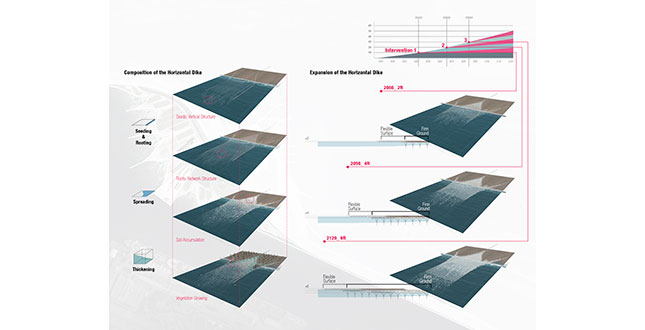 Close Me!
Close Me!Expanding Horizontally as Sea Level Rises
The first goal of the surface is defending inland area against sea level rise. As sea level rise, the Horizontal Dike expands. Due to the unique material of the dike - palm-carbon fiber, the surface of the dike floats on the water, creates interesting flexible surface which moves along with waves. Eventually, as the dike ex¬pands, decomposed organic materials will be layered on the surface and form thick and firm ground of soil.
Download Hi-Res ImageImage: Yongjun Jo, Kyungkun Lee
Image 8 of 15
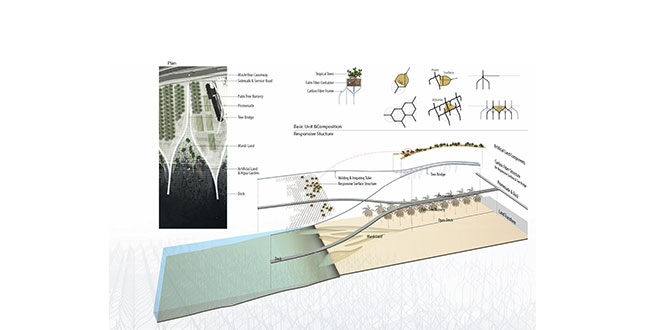 Close Me!
Close Me!Modular Structure for Future Expansion
With modular units of carbon fiber frames and palm fiber containers, the Horizontal Dike system can be easily assembled and installed based on the site condition. The deck and tree bridge support the load of the modular units and maintain the overall shape of the system.
Download Hi-Res ImageImage: Yongjun Jo, Kyungkun Lee
Image 9 of 15
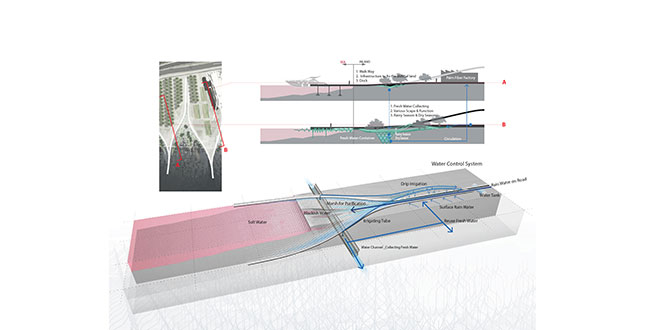 Close Me!
Close Me!Water Circulation - Blackish Water Reuse and Fresh Water Container
The modular units of the dike system not only spread horizontally, but also root vertically to the ground. Thick soil of the system purifies used waters, and purified water could be stored in the volume created by the underground modular units. This water will be reused for the Tree Bridge and the Seedling Farm.
Download Hi-Res ImageImage: Yongjun Jo, Kyungkun Lee
Image 10 of 15
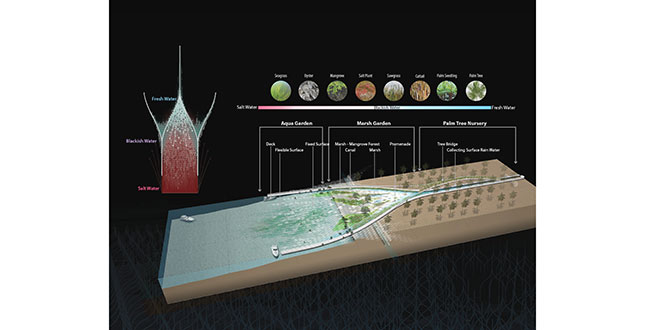 Close Me!
Close Me!Salt Water / Fresh Water Interface - Variety of Habitats
The shape and the structure of the dike system break the sea water and further guide it to the inland. Grey water flows along with the deck structure while being filtered by the thick surface. This makes the interface of the salt water and the fresh water, which creates smooth transition of the plant habitats.
Download Hi-Res ImageImage: Yongjun Jo, Kyungkun Lee
Image 11 of 15
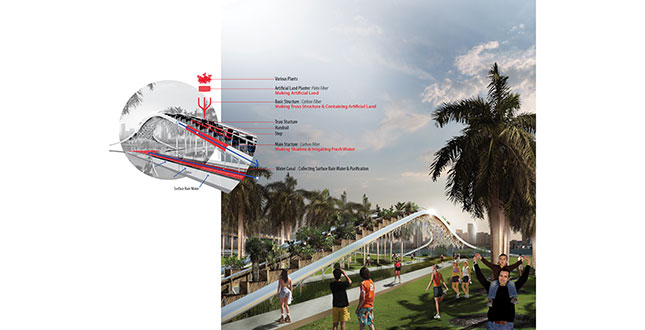 Close Me!
Close Me!Tree Bridge - Botanical Garden of Infrastructure
The pipe and the truss structure circulate water for the nursery as much as providing shade and sense of place. Palm seedlings and various plants in the baskets form a hanging garden while providing the material for the future artificial land.
Download Hi-Res ImageImage: Yongjun Jo, Kyungkun Lee
Image 12 of 15
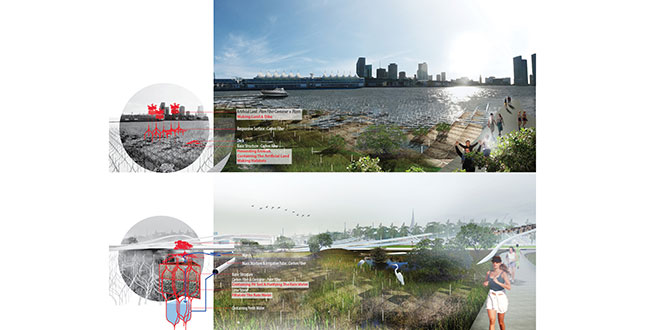 Close Me!
Close Me!Marsh Garden - Hybrid Surface of Natural and Artificial Material
The dike starts as thin and flexible infrastructure. However, it is not just shallow and light surface. Matured plants and mixed materials from the Tree Bridge will form layered surfaces, and as time passes, decom¬posed palm fiber container will be stuck to the frame and form thick ground. As sea level rises, this artificial ground will expand and get thicker, form rich salt water marsh.
Download Hi-Res ImageImage: Yongjun Jo, Kyungkun Lee
Image 13 of 15
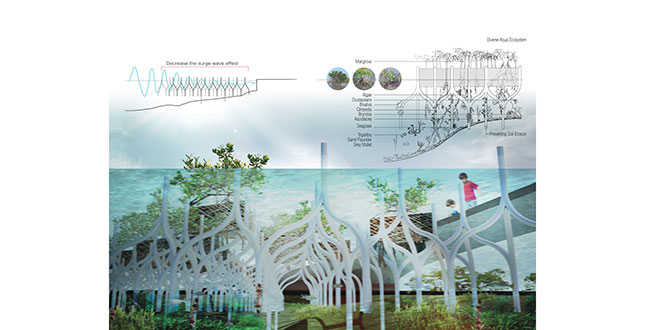 Close Me!
Close Me!Aquatic Garden - Habitat within Infrastructure
The underwater structure breaks the surge and provide porous surfaces, which are crucial to the growth of aquatic plants. The structure combined with vegetation will offer a new shelter for the tropical fishes as mangroves once did. The Matured Aquatic Garden will provide superior surge protection with carbon-fiber structure, plant roots and thick decomposed material.
Download Hi-Res ImageImage: Yongjun Jo, Kyungkun Lee
Image 14 of 15
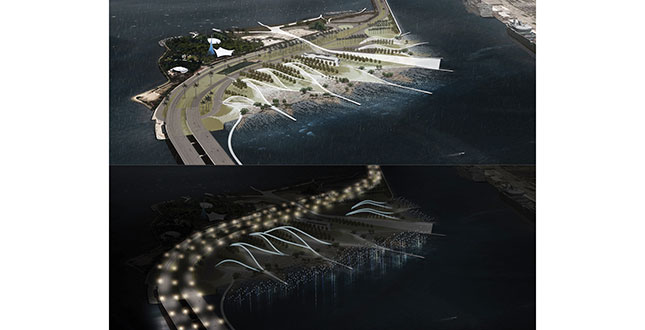 Close Me!
Close Me!The Horizontal Dike - Infrastructure driven by Natural Process
The Horizontal Dike will be a man-made infrastructure driven by natural process. It will break the edge between the urban fabric and the ocean, forming a liminal condition between the artificial and the natural. As sea level rise the surface will expand, therefore the protection and the attraction will also increase.
Download Hi-Res ImageImage: Yongjun Jo, Kyungkun Lee
Image 15 of 15
Project Statement
The Horizontal Dike, a new type of infrastructural waterfront protects Miami from sea level rise. Instead of drawing a clean border between the ocean and inland, the dike expands horizontally, provides rich platform for the future habitat and attraction. It will break the edge between the urban fabric and the ocean, forming liminal condition between the artificial and the natural. Ultimately, the Horizontal Dike will be a man-made infrastructure driven by natural process.
Project Narrative
Sea Level Rise and the Horizontal Dike System - Protection and Attraction
In about 100 years, sea level will rise up to 6ft and cause serious environmental and economic problem to Miami. We offer the Horizontal Dike, a new type of infrastructure that protects the city from sea level rise, and will turn the infrastructure into the new attraction of Miami.
Sea Level Rise - Imminent threat on Attractions and Ecosystem of Miami:
The impact of Sea Level Rise will start from the shore and further expands to the urban area and aquifer. The site of this project, Watson Island has all the characteristics that would reveal the damage and therefore has potential to be the test bed site to invent and test the infrastructure for the future use of the entire Biscayne Bay area.
Watson Island - Test Bed for the Horizontal Dike:
Once tested and prove its worthy, the Horizontal Dike on the Watson Island will be applied to the entire Biscayne Bay Area, and will eventually forms the new attraction loop to substitute the Miami Beach which will disappear in 50 years. Also, the Watson Island will be the starting point of the tour, depart form mere pass-through.
Horizontal Dike - New Infrastructural Waterfront of Protection and Attraction
The Horizontal Dike will evolve from points to surface and ultimately to volume as the root system of the mangroves inhabits and expands its territory while protecting the area from surge and inundation.
Responding to the Context and Threats:
Base vertical structures of the Horizontal Dikes will be placed according to the wave of the shore, so they will reduce the erosion and surge impact. The Horizontal Dike is not just infrastructure, but also extended urban fabric which offers various extended waterfront edge and surface conditions. The frame work of the dike will also be utilized as circulations to connect the existing museum and botanical garden so they could be part of the new urban waterfront.
Artificial Land driven by Natural Process:
The Horizontal Dike System is a hybrid of cutting edge technology and law of nature. It starts with the artificial land platform of special palm-carbon fiber, but will be eventually filled with decomposed organic materials such as palm fiber, soil, falling leaves and fruits which will form the fertile ground of the future habitat. All the process - both artificial and natural - of material-making happens in the site, which makes the Horizontal Dike system as a small yet unique ecosystem of a closed loop.
Expanding Horizontally as Sea Level Rises
The first goal of the surface is defending inland area against sea level rise. As sea level rise, the Horizontal Dike expands. Due to the unique material of the dike - palm-carbon fiber - the surface of the dike floats on the water and creates interesting flexible surface which moves along with waves. Eventually, as the dike expands, decomposed organic materials will be layered on the surface and form thick and firm ground of soil.
Modular Structure for Future Expansion:
With modular units of carbon fiber frames and palm fiber containers, the Horizontal Dike System can be easily assembled and installed based on the site condition. The deck and tree bridge support the load of the modular units and maintain the overall shape of the system.
Water Circulation - Blackish Water Reuse and Fresh Water Container:
The modular units of the dike system not only spread horizontally, but also root vertically to the ground. Thick soil of the system purifies used waters, and purified water could be stored in the volume created by the underground modular units. This water will be reused for the Tree Bridge and the Seedling Farm.
Salt Water / Fresh Water Interface - Variety of Habitats:
The shape and the structure of the dike system break the sea water and further guide it to the inland. Grey water flows along with the deck structure while being filtered by the thick surface. This makes the interface of the salt water and the fresh water, which creates smooth transition of the plant habitats.
Attraction
Tree Bridge - Botanical Garden of Infrastructure:
The pipe and the truss structure circulate water for the nursery as much as providing shade and sense of place. Palm seedlings and various plants in the baskets form a hanging garden while providing the material for the future artificial land.
Marsh Garden - Hybrid Surface of Natural and Artificial Material:
The dike starts as thin and flexible infrastructure. However, it is not just shallow and light surface. Matured plants and mixed materials from the Tree Bridge will form layered surfaces, and as time passes, decomposed palm fiber container will be stuck to the frame and form thick ground. As sea level rises, this artificial ground will expand and get thicker, form rich salt water marsh.
Aquatic Garden - Habitat within Infrastructure:
The underwater structure breaks the surge and provide porous surfaces, which are crucial to the growth of aquatic plants. The structure combined with vegetation will offer a new shelter for the tropical fishes as mangroves once did. The Matured Aquatic Garden will provide superior surge protection with carbon-fiber structure, plant roots and thick decomposed material.
The Horizontal Dike - Infrastructure driven by Natural Process
The Horizontal Dike will be a man-made infrastructure driven by natural process. It will break the edge between the urban fabric and the ocean, forming a liminal condition between the artificial and the natural. As sea level rise the surface will expand, therefore the protection and the attraction will also increase.




